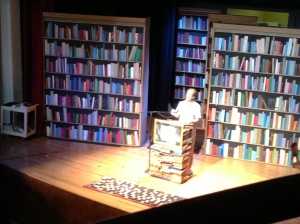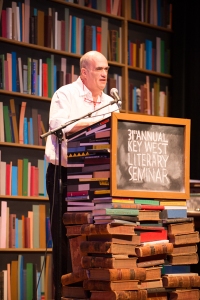[gallery type="slideshow" ids="1529,1530,1531,1532,1533,1534,1510,1535"]
For the last year, almost all of our books have been in boxes. (I use the first person plural here to refer to my husband and me, not in some pretentious royal sense, by the way.) We packed in March of last year, moved in April and have been recovering ever since. A few times over the last year, I thought maybe we shouldn't have so many books in the first place because we managed to get along without them. But I missed them -- not just specific books I wanted for a specific reason, but the comfort of those volumes we had kept because we loved them so -- and those that we hadn't read yet, so they were still full of promise.
In the last month we finally got our friend Rudi to build the set of bookshelves we had envisioned. No, that's not true. We envisioned a big set of shelves on a mostly blank wall. Our architect friends told us we should fill in the entire wall, all the way up to the peak. Rudi took that concept, and the existing circular window, and turned it into art.
A little more than a week ago it was finally done -- the fitting and cutting and sanding and varnishing. It was finally time to start emptying the boxes. Then we had to figure out how to shelve the books.
I hadn't worried about this too much -- in fact, I'd looked forward to it -- because I'd assumed that since I work in a library, my opinions on this would rule the day. I wasn't planning to insist on Dewey Decimal shelving (or, God forbid, Library of Congress). But I figured we'd divide it by fiction vs. nonfiction, shelve the fiction alphabetically like we do at the library, and shelve the nonfiction roughly by subject.
Mark objected on the grounds that "systems never work." (Tell that to all the cataloguers and shelvers in the world, honey!) But I quickly realized that in our particular situation, he was right -- my proposed system wouldn't work -- or if it did, it would require regular use of an extension ladder. We are both very fond, for example, of the works of Michael Chabon. But if we went alphabetically, he'd wind up 13 feet up.
Our fabulous new bookshelf does indeed go all the way to the peak. Which is 15 feet. It doesn't include a ladder. It probably should, but attaching hardware to this baby would kill me. So the books going on the high-up shelves are books that, by necessity, we don't expect to be consulting any time soon. Which means they are absolutely perfect for the books that used to make us feel terribly guilty for taking up shelf space. Books we've read, don't expect to read again but just can't let go of. Books that loved ones gave us that we can't bear to give away .I've got a few like that from my dad, who was a serious book hound in his later years. I treasure "Yesterdays: A History of Massachusetts State College 1863-1933," a book about the institution that later became UMass Amherst, where my parents both spent their entire working lives and is my alma mater. But I don't expect to sit down and read it any time soon, if ever.
Mark agreed with the fiction vs. nonfiction divide, with a couple of exceptions where ambidextrous authors like Nick Hornby are shelved all together, or a novelist's single book of essays -- like Chabon's "Maps and Legends" -- go with his other works. Our Trinidad section includes fiction and non. Otherwise, fiction is kind of a free-for-all though it's been unexpectedly liberating to just be able to put the books wherever we choose, defying the tyranny of the alphabet. We grouped writer's works together. We put things within arm's reach that are either in the lineup or likely to be soon. Both of us are working our way, slowly, through Patrick O'Brian so those books have a nice chin-level spot. I've arranged some recent writers from the Key West Literary Seminar together, something I'd never get away with at a "real" library except as a temporary display. I've got a section of galleys which we get at the library -- if I don't get to them in a certain amount of time, I tend to give them away so they'll circulate. True crime, a growing interest especially the historical stuff, is on the bottom shelf. It's a tad inconvenient but it's accessible.
Nonfiction was both easier and trickier. Except for the high-up books, we agreed to group those basically by subject -- but our categorizing is broad to say the least. There's natural history/science. There are essays, nonfiction about literature (including essays) and a small section of books about books. There's European history, English history and American history. I put those in mostly chronological order, though I separated out the omnibus volumes from the books that chronicle more specific times and people. I was the littlest bit sorry to see that I apparently purged Norman Davies' massive tome "The Isles," which had been sitting on my shelves reproaching me, both for being silly enough to buy the damned thing and then not reading it, for well over a decade. I'd actually have room for it now and the shelves would suit a four-inch monster like that. And I always feel comforted to own a bunch of doorstopping tomes, in case my library and I survive the apocalypse and my Kindle purchases aren't available in the post-apocalyptic era.
We're still settling into our relationship with this bookshelf. I plan some minor re-organizing within the natural history/science section. But it's just about set and it is truly wonderful to have almost all of our books in one place. The scariest part is that there is room to grow.
Not very closely related but still interesting, if you're interested in things like shelving and classification is this recent blog post from a reference librarian, objecting to the label "non-fiction" as an organizing concept for libraries. I'd never thought about it but it IS kind of irritating that such a broad and diverse array of books is most essentially defined by what it is not.
 The great children's book writer E.L. Konigsburg died over the weekend, a piece of news I barely noticed in all the emotional tumult of the news from Boston. Like millions of other book-loving kids, I loved From the Mixed-Up Files of Mrs. Basil E. Frankweiler -- it described exactly the sort of running away experience I wished I were cool and smart enough to pull off. She won the Newbery Medal for that book and again in 1997 for The View from Saturday. But the book of hers that I love the most -- and recommend to readers both young and not-so-much to this day -- is A Proud Taste for Scarlet and Miniver. I am so very glad it is in the collection of the library where I work so I can read it again every couple of years.
The only bad thing I have to say about this book is that its title is impossible to remember. And I still don't even know what miniver is. How Konigsburg got away with her long and obscure titles beats me (her first book is called Jennifer, Hecate, MacBeth, William McKinley and me, Elizabeth). It must have been before marketing departments had much sway in publishing houses.
The great children's book writer E.L. Konigsburg died over the weekend, a piece of news I barely noticed in all the emotional tumult of the news from Boston. Like millions of other book-loving kids, I loved From the Mixed-Up Files of Mrs. Basil E. Frankweiler -- it described exactly the sort of running away experience I wished I were cool and smart enough to pull off. She won the Newbery Medal for that book and again in 1997 for The View from Saturday. But the book of hers that I love the most -- and recommend to readers both young and not-so-much to this day -- is A Proud Taste for Scarlet and Miniver. I am so very glad it is in the collection of the library where I work so I can read it again every couple of years.
The only bad thing I have to say about this book is that its title is impossible to remember. And I still don't even know what miniver is. How Konigsburg got away with her long and obscure titles beats me (her first book is called Jennifer, Hecate, MacBeth, William McKinley and me, Elizabeth). It must have been before marketing departments had much sway in publishing houses.

